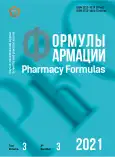Interactomics and personalized pharmacotherapy – present and looking to the future
- Authors: Tyukavin A.I.1, Studneva M..2,3, Suchkov S.V.2,4,3
-
Affiliations:
- Saint Petersburg State Chemical and Pharmaceutical University of the Ministry of Health of the Russian Federation
- Moscow State University of Food Production
- EPMA (European Association for Predictive, Preventive and Personalized Medicine)
- A.I. Yevdokimov Moscow State University of Medicine and Dentistry
- Issue: Vol 3, No 3 (2021)
- Pages: 68-77
- Section: Actual problems: discussion tribune
- URL: https://journals.rcsi.science/PharmForm/article/view/86311
- DOI: https://doi.org/10.17816/phf86311
- ID: 86311
Cite item
Full Text
Abstract
The review highlights the advances in natural science that form the basis of the concept of personalized and precision medicine (PPM). The provisions of PPM (prediction, prevention, personalization) have been disclosed and modern molecular genetic tools have been shown, which are used in leading scientific and practical biomedical centers to improve the quality of treatment of patients with multifactorial diseases (MFD). The main principles of molecular genetic biomarking of MFDs, as well as gene technologies (CRISPR, non-coding RNA, etc.) used in medical practice and at the stage of clinical trials were highlighted. Particular attention has been paid to molecular genetic methods of targeted therapy for cancer, including antitumor vaccines. Scientific developments in the field of prediction and preventive treatment of MFD have been considered - precision healing technologies of tomorrow. The main provisions of interactomics as an interdisciplinary field of natural science have been highlighted, as well as the applied aspects of this section of fundamental science for the development of diagnostic and treatment-and-prophylactic technologies of a new generation.
Full Text
##article.viewOnOriginalSite##About the authors
Alexander I. Tyukavin
Saint Petersburg State Chemical and Pharmaceutical University of the Ministry of Health of the Russian Federation
Author for correspondence.
Email: alexander.tukavin@pharminnotech.com
SPIN-code: 8476-5366
Scopus Author ID: 6603645369
ResearcherId: V-6699-2017
Doctor of Medicine (MD), Professor, Head of the Department to Physiology and Pathology
Russian Federation, Saint PetersburgMaria A. Studneva
Moscow State University of Food Production; EPMA (European Association for Predictive, Preventive and Personalized Medicine)
Email: maria.studneva@gmail.com
assistant of the Department to Personalized Medicine, Precision Nutrition and Biodesign
Russian Federation, Moscow; BrusselsSergei V. Suchkov
Moscow State University of Food Production; A.I. Yevdokimov Moscow State University of Medicine and Dentistry; EPMA (European Association for Predictive, Preventive and Personalized Medicine)
Email: ssuchkov57@gmail.com
Doctor of Medicine (MD), Professor, Head of the Department to Personalized Medicine, Precision Nutrition and Biodesign, Professor of the Department of Clinical Allergology and Immunology
Russian Federation, Moscow; Moscow; BrusselsReferences
- Suchkov S. V., ed. Basics of Personalized and Precision Medicine. Textbook for students of medical universities and faculties. Kazan: MedDoc Mublishing House; 2021. 628 p. (In Russ.).
- Tykavin A. I., ed. Pathology: textbook. Moscow: INFRA-M; 2021. 844 p. (In Russ.).
- Filatova A. Yu., Sparber P. A., Krovisheeva I. A., et al. Long noncoding RNAs are a promising therapeutic target in various diseases. Vestnik RGMU = Bulletin of RSMU. 2017:(3);5-17. https://doi.org/10.24075/BRSMU.2017-03-01. (In Russ.).
- Tyukavin A. I., Belostotskaya G. B., Zakharov Е. А., et al. Apoptotic Bodies of Cardiomyocytes and Fibroblasts – Regulators of Directed Differentiation of Heart Stem Cells. Bull Exp Biol Med. 2020;170(1):112-117. https://doi.org/10.1007/s10517-020-05015-0. (In Russ.).
- Tsarev I. L., Melerzanov A. V. Review of approaches to immunotherapy in oncology. Issledovaniya i praktika v medicine = Research and Practical Medicine Journal. 2017;4(3):51-65. https://doi.org/10.17709/2409-2231-2017-4-3-5. (In Russ.).
- Goryaev A. A., Savkina M. V., Obukhov Yu. I., et al. DNA and RNA Vaccines: Current Status, Quality Requirements and Specific Aspects of Preclinical Studies. BIOpreparaty. Profilaktika, diagnostika, lechenie = BIOpreparations. Prevention, Diagnosis, Treatment. 2019;19(2):72-80. https://doi.org/10.30895/2221-996X-2019-19-2-72-80. (In Russ.).
Supplementary files






















